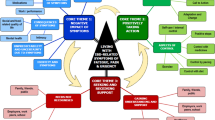Abstract
An invitation to attend the inaugural meeting of a self-help group and a questionnaire were sent to 2084 patients with inflammatory bowel disease (IBD). Twelve months later 180 patients who had joined the group (n=90) and a similar number who had not, were sent a second questionnaire seeking why they had or had not, and what functions the group had managed to fulfill. 254 (13%) responded and 138 (7%) joined. Patients with Crohn's disease (ϰ2 = 5.43, P=0.02) and women (ϰ2 = 3.80, P<0.05) were more likely to join. These differences were not seen amongst the Asians who responded to the questionnaire (ϰ2 = 0.01, ns) who were much less likely to respond (ϰ2 = 15.1, P>0.0001). Responders wanted the group to provide an information service (85%) to give an opportunity to discuss problems with other patients (77%) and to promote the needs of people with IBD to the local community. 88% (n=159) responded to the second questionnaire, including 83 from joiners and 76 from non-joiners. Forty-seven (57% of joiners) had attended meetings. Answers indicated the group provided useful general information (99%), mutual support (66%), information on medical research (70%) and an opportunity to meet (60%). Amongst nonjoiners, 81% (n=62) thought such a group might be useful. Reasons for not joining included: too busy (40%), too far away (23%), managing without support (28%) and reluctance to broadcast their illness (20%).
Résumé
Une invitation à assister à le réunion inaugurale d'un groupe d'aide personnelle et un questionnaire ont été envoyés à 2084 patients avec une maladie inflammatoire du colon. 12 mois plus tard, 180 patients qui avaient rejoint le groupe (n=90) et un nombre similaire qui ne l'avait pas fait ont reçu un deuxième questionnaire cherchant pourquoi ils avaient ou non fait cela et quelles fonctions le groupe avait décidé de remplir. 254 (13%) ont répondu et 138 (7%) ont rejoint le groupe. Les patients avec maladie de Crohn (ϰ2 = 5.43, P=0.02) et les femmes (ϰ2 = 3.80, P>0.05) étaient susceptibles de rejoindre le groupe. Ces différences n'étaient pas vues parmi les asiatiques qui ont répondu au questionnaire (ϰ2 = 0.01, ns) qui étaient beaucoup moins susceptible de répondre (ϰ2 = 15.1, P>0.0001). Les répondeurs demandaient au groupe de fournir un service d'informations (85%) de donner une opportunité de discuter des problèmes avec d'autres malades (77%) et de promouvoir les besoins des gens atteints de maladie inflammatoire dans la communauté locale. 88% (n=159) ont répondu au deuxième questionnaire, incluant 83 de ceux qui avaient rejoint et 76 de ceux qui n'avaient pas rejoint le groupe. 47 (57% de ceux qui avaient rejoint) ont suivi les réunions. Les répondeurs ont indiqué que le groupe fournissait des informations générales utiles (99%) une aide mutuelle (66%), des informations sur la recherche médicale (70%) et une opportunité de se rencontrer (60%). Parmi ceux qui n'avaient pas rejoint, 81% (n=62) pensaient qu'un tel groupe pouvait être utile. Les raisons de ne pas rejoindre comprenait: trop occupé (40%), trop loin (23%) pas de support (28%) et répugnance à diffuser leur maladie (20%).
Similar content being viewed by others
References
Jayanthi V, Probert CSJ, Pinder D, Wicks ACB, Mayberry JF (1992) Epidemiology of Crohn's disease in Indian migrants and the Indigenous population in Leicestershire. Q J Med 82:125–138
Probst CSJ, Jayanthi V, Pinder D, Wicks ACB, Mayberry JF (1992) Epidemiology of ulcerative colitis in Indian migrants and the Indigenous population in Leicestershire. Gut 33:113–125
Martin A, Castagliuolo I, Leone L, Sturniolo GC, Mastropaolo G, Di Mario F, Naccarato R (1990) What do patients want to know about inflammatory bowel disease. Gut S33:44
Mayberry JF, Morris JS, Calcraft B, Rhodes J (1985) Information assessment by patients of a booklet on Crohn's disease. Public Health 99:239–242
Kulcar Z (1991) Self-help, mutual aid and chronic patients' clubs in Croatia, Yugoslavia: discussion paper. J R Soc Med 84:288–291
Braden CJ (1990) A test of the self-help model: Learned response to chronic illness experience. Nurs Res 39:42–47
Probert CSJ, Mayberry JF (1991) Inflammatory bowel disease: patients expectations in the 1990's. J R Soc Med 84:132–133
Mayberry JF (1987) The role of local self-help groups for people with inflammatory bowel disease. Int J Colorect Cancer 2:15–16
Moody GA, Probert CSJ, Jayanthi V, Mayberry JF (1992) The attitude of employers to people with inflammatory bowel disease. Soc Sci Med 34:459–460
Author information
Authors and Affiliations
Rights and permissions
About this article
Cite this article
Moody, G.A., Bhakta, P. & Mayberry, J.F. Disinterest in local self-help groups amongst patients with inflammatory bowel disease in Leicester. Int J Colorect Dis 8, 181–183 (1993). https://doi.org/10.1007/BF00290301
Received:
Accepted:
Issue Date:
DOI: https://doi.org/10.1007/BF00290301




